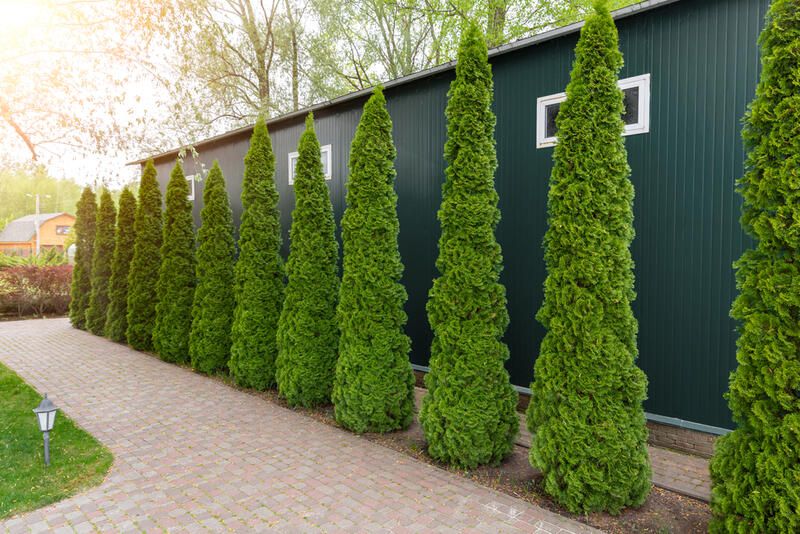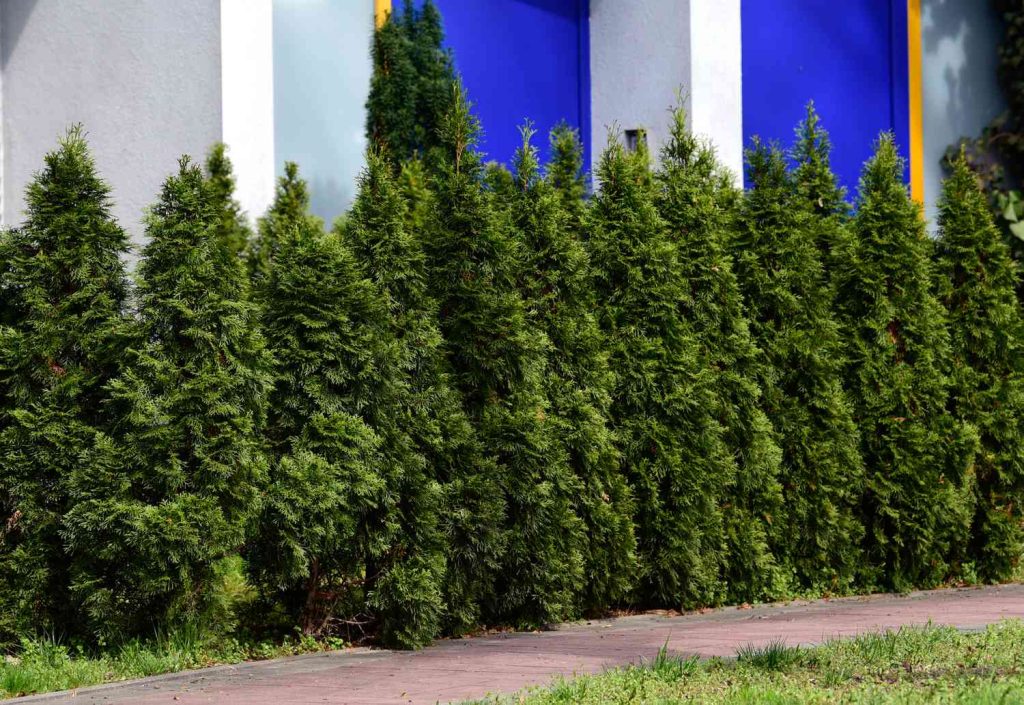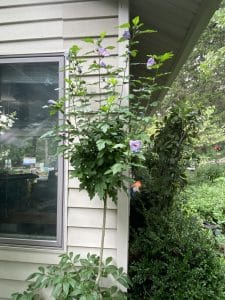Maintaining the health and look of your trees is critical for a stunning landscape. This lesson will go over the subtleties of how to trim an arborvitae tree. Whether you’re an experienced gardener or a beginner, this expert advice and strategies will help you keep your trees healthy and your yard looking great.
Understanding Arborvitae Trees
People admire Arborvitae trees, also known as Thuja, for their lush foliage and graceful beauty. These are evergreens that act as privacy screens, windbreaks, and beautiful landscape examples. Arborvitae trees are available in a variety of species and cultivars, including Emerald Green and Green Giant, to suit varied preferences and situations. Regular trimming is critical for preserving their health and shape, boosting air circulation, and lowering the risk of disease. Understanding the distinct qualities and care requirements of arborvitae trees allows homeowners to guarantee that their landscapes remain lively and beautiful all year.
Benefits of Trimming Arborvitae Trees
Trimming arborvitae trees regularly has numerous benefits for their overall health and appearance, extending the lifespan and vitality of these treasured evergreens. For starters, cutting improves air circulation within the tree canopy, reducing the risk of fungal diseases and pest infestations that thrive in dense foliage. Trimming removes potential entry points for pathogens, increasing the tree’s resilience to illness. Trimming the tree also promotes balanced growth and minimises overcrowding, ensuring that each branch receives enough sunlight and nutrients for optimal development. Furthermore, regular trimming helps to keep the arborvitae at the right size and shape, preventing it from outgrowing its assigned landscape space. Overall, cutting arborvitae trees has long-term benefits beyond aesthetics, improving their health and resistance to environmental challenges.
Tools needed for trimming arborvitae trees
To properly trim arborvitae trees, you will need a few key tools. Here are the tools you’ll need:

Pruning shears, hand pruners, or secateurs are used to trim small branches and twigs precisely.
Loppers are larger, long-handled pruning tools that can easily chop through thicker branches, providing more reach and leverage.
Pruning Saw: To trim larger branches that are too thick for pruning shears or loppers to handle, use a pruning saw. For better maneuverability, look for a saw with a curved blade.
A hand-pruning saw is handy for accessing confined spots and making precise cuts while performing more delicate trimming operations.
Safety Gear: When pruning arborvitae trees, prioritize safety by wearing gloves, safety glasses, and strong footwear.
How to trim an arborvitae tree?
Step-by-Step Guide to Trimming Arborvitae Trees
Trimming arborvitae trees demands careful attention to detail and the right technique to ensure the tree’s health and appearance. Follow this step-by-step guide to prune your arborvitae trees properly:
Inspect the Tree: First, check the arborvitae tree for signs of damage, sickness, or dead branches. Identify the branches that need to be trimmed to promote healthy growth.
Gather Your Instruments: Ensure that you have all of the trimming instruments you will need, including pruning shears, loppers, a pruning saw, and safety gear.
Begin with Dead or Diseased Branches: To remove any dead, damaged, or diseased branches, use pruning shears or loppers. Cut these branches down to the nearest healthy growth point or trunk.
Shape the Tree: After removing the dead or diseased limbs, begin shaping the tree to its desired size and shape. Trim back any overgrown or stray branches to keep things looking nice and tidy.
Prune to improve air circulation: remove congested branches from the tree’s interior. This will increase air circulation within the canopy, lowering the danger of fungal illness.
Avoid Over-Pruning: Do not over-prune the arborvitae tree, since this can weaken it and make it susceptible to stress and disease. Aim to preserve the tree’s natural shape and structure as much as possible.
Step back and examine: As you trim the tree, take periodic breaks to examine your work. This will help you get the ideal form and balance.
Clean Up Debris: Once you’ve completed trimming the tree, collect and dispose of any debris to keep it from becoming a breeding ground for pests or diseases.
By following these instructions, you may confidently trim your arborvitae trees, maintaining their health and improving the appearance of your landscape.
What should I do if my arborvitae tree has grown too tall?
If your arborvitae tree has grown too big for its assigned place, you have many choices for managing its height while maintaining a harmonious landscape:
Selective Pruning: Trim back the topmost branches to lessen the tree’s total height while preserving its original shape. Remove only the tallest branches to prevent an uneven or unbalanced appearance.
Crown Reduction: Selectively remove higher branches to reduce the tree’s height while maintaining structural integrity. This approach promotes lateral development and balances the tree’s canopy.
Gradual Reduction: Over time, reduce the tree’s height by pruning back a portion of its higher branches each year. This strategy helps the tree gradually respond to the changes, reducing stress.
Consult a Professional: If the tree is too big or large for DIY trimming, consider hiring a professional arborist. They can evaluate the tree’s condition and recommend the best course of action, which may include crown thinning or tree removal if necessary.
By taking proactive actions to maintain your arborvitae tree’s height, you can keep it both beautiful and functional in your environment.
Related Posts:
Hiring professionals to trim arborvitae trees
Hiring specialists to trim your arborvitae trees can provide various benefits, especially if you don’t have the proper tools, experience, or time to do it yourself. Professional arborists have the knowledge and experience to trim trees safely and effectively, ensuring the best results while reducing the danger of damage or injury. They may assess the health and condition of your arborvitae trees, recommend proper trimming procedures, and provide helpful advice on tree care and maintenance. Hiring specialists also saves you time and effort, enabling you to devote more time to other elements of your landscaping or life. Investing in expert tree trimming services enables you to enjoy beautifully manicured arborvitae trees without the hassle and worry of DIY care.
FAQS
How much may I prune my arborvitae trees at once?
Experts generally recommend pruning no more than one-third of the overall foliage at one time. Pruning excessively might startle the tree and harm its health.
How can I prune arborvitae trees to keep them in their natural shape?
Begin by eliminating dead or broken branches, then use selective pruning to thin down dense regions. Take occasional steps back to check the tree’s contours and avoid over pruning. To promote bushier growth, trim branches above a healthy outward-facing bud or lateral branch.
Can you trim arborvitae trees into specific shapes, like hedges?
Arborvitae trees are widely used as hedges and can be cut into different designs, such as cones, spirals, and straight lines. Use stakes and threads as guides to achieve uniform shapes, and trim regularly to keep the desired shape.
Should I apply anything to the cuts after pruning?
Often, it is unnecessary to apply wound dressing or sealant to pruning cuts on arborvitae trees. They usually heal nicely on their own. If you’re concerned about disease or pests, use a pruning sealer made exclusively for trees.
How frequently should I cut my arborvitae trees?
The desired size and shape of the tree determine the frequency of pruning. Formal hedges may require trimming every 1-2 months during the growing season. For less formal shapes, an annual trim in late winter or early spring is typically sufficient.
In the summer, can I prune my arborvitae trees?
Although we generally avoid extensive trimming during the warmer months, we can perform modest maintenance pruning as needed. Avoid pruning during hot, dry weather to reduce stress on the tree.
Conclusion
Finally, while we’ve addressed the subtleties of pruning arborvitae trees, it’s important to consider the larger context of tree care and upkeep, including the occasional need for magnolia tree removal. Understanding the appropriate procedures for cutting arborvitae trees allows homeowners to guarantee the health and lifespan of these cherished evergreens while improving their landscapes’ attractiveness. However, if magnolia tree removal becomes necessary, hiring professional help is critical to ensuring the safety and aesthetics of your property. Whether cutting arborvitae trees or eliminating magnolia trees, prioritising good tree care methods helps create a lively and healthy outdoor environment. Remember that each tree is an important part of the landscape’s ecosystem, and by taking proper care of them, we can enjoy their beauty for future years.





